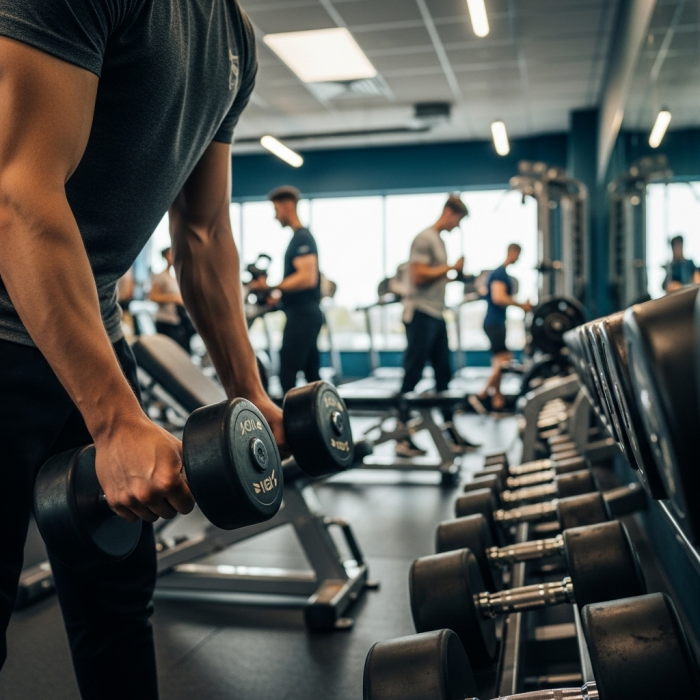Choosing the right dumbbell weight can make all the difference in your workout success. If your weights are too heavy, you risk injury or poor form.
Too light, and you might not see the results you want. You want to challenge your muscles just enough to grow stronger without overdoing it. But how do you find that perfect balance? Keep reading, and you’ll discover simple, effective tips to pick the right dumbbell weight for your fitness goals—so every workout counts and keeps you motivated to push forward.

Factors To Consider
Choosing the right dumbbell weight helps you exercise safely and effectively. It is important to pick a weight that fits your needs and ability.
Several factors affect the best dumbbell weight for you. Think about your goals, strength, and workout plan.
Fitness Goals
Your fitness goals guide the dumbbell weight you should use. Different goals need different weights.
If you want to build muscle, choose heavier weights with fewer repetitions. For toning, pick lighter weights with more reps.
- Build muscle: heavier weights, 6-12 reps
- Tone muscles: lighter weights, 12-20 reps
- Increase endurance: light weights, high reps
Current Strength Level
Know your current strength before picking dumbbells. Start with weights that feel comfortable and safe.
Choose a weight that challenges you but lets you keep good form. Avoid weights that are too light or too heavy.
- Beginner: start with 2-5 pounds
- Intermediate: try 8-15 pounds
- Advanced: use 20+ pounds
Exercise Types
The type of exercise affects the dumbbell weight you need. Some moves use lighter weights, others need heavier ones.
For example, exercises for small muscles use lighter weights. Big muscle exercises can handle heavier weights.
- Isolation exercises: lighter weights
- Compound exercises: heavier weights
- Rehabilitation: very light weights
Frequency And Duration
How often and how long you work out affects dumbbell weight choice. More frequent sessions may need lighter weights.
If you exercise for a short time, heavier weights can be used. For longer workouts, lighter weights help avoid fatigue.
- Daily workouts: lighter weights
- Few times a week: moderate to heavy weights
- Long sessions: lighter weights for endurance

Weight Selection Guidelines
Choosing the right dumbbell weight helps you exercise safely and effectively. Picking weights that fit your strength level can improve your results.
These guidelines will help you find the best dumbbell weight for your workouts. You will learn how to start, progress, and adjust weights.
Starting Light
Begin with light weights to learn proper form. Lifting too heavy at first can cause injury. Light weights help your muscles get used to the movement.
Choose weights that let you do 12 to 15 repetitions without pain or struggle. Focus on control and smooth motion.
Progressive Overload
To build strength, increase your dumbbell weight gradually. Add small weight increases as you get stronger. This is called progressive overload.
Keep challenging your muscles to grow by lifting heavier weights or doing more reps over time.
- Add 2 to 5 pounds every 1 to 2 weeks
- Increase reps from 12 to 15 before adding weight
- Rest well between workouts for recovery
Testing Your Limits
Test your dumbbell weight by trying a set with good form. The last 2 reps should feel hard but doable. If you cannot keep form, the weight is too heavy.
Use testing to find your right weight. Adjust if you feel pain or cannot complete sets.
Adjusting For Muscle Groups
Different muscles need different dumbbell weights. Larger muscles like legs can handle more weight. Smaller muscles like arms need lighter weights.
- Leg exercises: heavier weights, fewer reps
- Arm exercises: lighter weights, more reps
- Back exercises: moderate to heavy weights
- Shoulder exercises: moderate weights
Common Mistakes To Avoid
Choosing the right dumbbell weight is important for safe workouts. Many people make mistakes that slow progress or cause injury.
Knowing what to avoid helps you pick the best weight for your fitness level and goals.
Choosing Too Heavy
Picking dumbbells that are too heavy can cause strain and injury. It also hurts your form and control.
Start with lighter weights. Increase weight only when you can do exercises easily with good form.
- Heavy weights can lead to muscle strain
- They reduce your ability to do full range of motion
- Using too much weight can cause bad habits
Ignoring Form
Bad form can cause injuries and stop you from gaining strength. Using the right weight helps keep your form correct.
Focus on how you move the dumbbells. If your form breaks down, lower the weight to stay safe.
- Keep your back straight
- Control the movement
- Do not use momentum to lift
Neglecting Warm-up
Starting with cold muscles increases injury risk. A warm-up prepares your body for lifting weights.
Spend 5 to 10 minutes doing light cardio or stretching before using dumbbells.
- Warm muscles move better
- Warm-up reduces muscle stiffness
- It improves blood flow to muscles
Skipping Rest Days
Rest days help your muscles recover and grow. Lifting weights every day can cause fatigue and injury.
Include rest days in your schedule. Your body needs time to repair after hard workouts.
- Rest prevents overuse injuries
- It helps build muscle strength
- Rest improves long-term workout results
Dumbbell Types And Features
Choosing the right dumbbell weight depends on many factors. Knowing the types and features helps you pick the best one.
Dumbbells vary in design, material, and storage options. These details affect comfort and workout efficiency.
Fixed Vs Adjustable
Fixed dumbbells have a set weight that cannot change. They are easy to use and quick to grab.
Adjustable dumbbells let you change the weight by adding or removing plates. They save space and cost less over time.
- Fixed dumbbells are simple and durable
- Adjustable dumbbells offer many weight options
- Fixed sets take more space
- Adjustable types reduce clutter
Material And Grip
Dumbbells come in different materials like metal, plastic, or rubber. Each has its pros and cons.
Grip comfort is important to avoid slipping. Look for textured or padded handles for a secure hold.
- Metal dumbbells are heavy and long-lasting
- Rubber-coated dumbbells protect floors
- Plastic dumbbells are light and cheap
- Textured grips reduce hand slipping
- Padded grips increase comfort
Space And Storage
Think about where you will keep your dumbbells. Space limits the type and number you can have.
Adjustable dumbbells need less space. Fixed dumbbells usually require racks or shelves for storage.
- Adjustable dumbbells save floor space
- Fixed dumbbells need storage racks
- Consider portability for small spaces
- Choose compact designs to save room
Expert Tips For Success
Choosing the right dumbbell weight helps you exercise safely and effectively. Picking the correct weight supports your strength goals and avoids injury.
Use these expert tips to select dumbbells that match your fitness level and needs. Adjust your choices as you get stronger.
Tracking Progress
Keep track of the weights you use and your reps. This helps you see your growth and know when to increase weight.
Write down your workouts or use a fitness app to record your progress. Small improvements show you are on the right path.
Mixing Weight Ranges
Use different dumbbell weights for various exercises. Lighter weights work well for warm-ups and high reps.
Heavier dumbbells help build strength on major muscle groups. Mixing weights keeps your workouts balanced and effective.
- Use light weights for shoulders and arms
- Choose medium weights for legs and back
- Pick heavy weights for chest and core exercises
Incorporating Variety
Change your dumbbell weights regularly to avoid plateaus. Varying weight challenges your muscles in new ways.
Try different exercises with different weights. This keeps workouts interesting and helps all muscle groups grow.
Listening To Your Body
Pay attention to how your body feels during workouts. Stop if you feel sharp pain or discomfort.
Choose weights that challenge you but do not cause strain. Rest when needed and increase weights slowly.

Frequently Asked Questions
What Factors Determine The Right Dumbbell Weight?
Choosing the right dumbbell weight depends on your fitness level and goals. Beginners should start with lighter weights. Consider your strength, endurance, and the specific exercises you’ll perform. Test different weights to find one that challenges you without compromising form.
How Can I Test The Appropriate Dumbbell Weight?
To test, perform 8-12 reps with proper form. If the last few reps are challenging but doable, you’ve found your weight. If you can’t maintain form, try a lighter weight. Conversely, if it’s too easy, increase the weight slightly.
Should Beginners Start With Lighter Dumbbells?
Yes, beginners should start with lighter weights to learn proper form. This helps prevent injury and builds a foundation. Gradually increase the weight as your strength improves. Focus on consistent progress rather than starting with heavy weights.
Can I Use Different Weights For Different Exercises?
Absolutely, using varied weights for different exercises is beneficial. Some exercises require more strength, like deadlifts, while others, like lateral raises, need lighter weights. Adjust according to the exercise and muscle group targeted for optimal results.
Conclusion
Choosing the right dumbbell weight helps you train safely and effectively. Start with a weight that feels comfortable but still challenges your muscles. Gradually increase the weight as you get stronger. Pay attention to your body and avoid lifting too heavy too soon.
Consistency matters more than lifting the heaviest weights. Keep track of your progress and adjust weights as needed. Enjoy your workouts and stay patient. The right dumbbell weight supports steady improvement and helps prevent injuries. Simple choices lead to better results over time.



